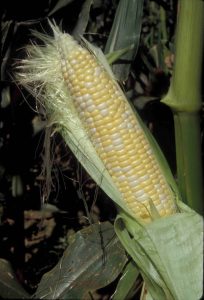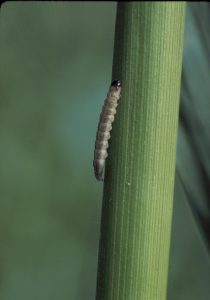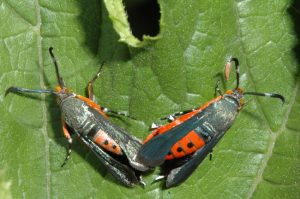Sweet Corn IPM Newsletter No. 2 – June 30, 2017
 Sweet Corn IPM Newsletter No. 2 – June 30, 2017
Sweet Corn IPM Newsletter No. 2 – June 30, 2017
Click on photos to enlarge.
Highmoor Farm Field Day
Wednesday, July 26, 2017
Save the date!
CORN EARWORM THREATENS EARLY SILKING CORN
European Corn Borer Feeding in Pre-Tassel Fields
SITUATION
Cool, wet growing conditions this spring delayed planting in many fields, and those that were planted early have been slow to get established. Early fields in southern Maine are coming into pre-tassel and a few fields that were transplanted or started under plastic or row covers are just starting to silk. Both corn earworm and European corn borer are already active in much of the state, and pose a threat to these early silking fields.

European corn borer: Moths were caught in pheromone traps all around the state this week, and larval feeding damage is showing up on early corn. In whorl stage corn the control threshold is 30% of plants showing feeding injury. Once the plants reach the pre-tassel stage the threshold is lowered to 15%, because larvae at this stage are more likely to damage the ears. Early fields in North Berwick, Poland Spring and Sabattus were over threshold for either whorl or pre-tassel corn, so sprays were recommended. Once corn reaches the silk stage, sprays may be based on the number of corn borer moths caught in pheromone traps rather than feeding injury. If more than 5 moths are caught in pheromone traps in a week near silking corn, a spray is recommended to prevent moths from laying eggs on the flag leaves of the ears, which could lead to larvae infesting the ears while leaving no visible signs of feeding on the leaves. One early silking field in Dayton was over the 5-moth threshold this week.
Corn earworm: Moths were caught in pheromone traps around much of the state this week. This is a fairly early arrival; but not too surprising, because much of our weather in the past few weeks has been moving up from the south, carrying moths with it. However, there is very little silking corn available for the moths to lay eggs on at this time, so the threat is very low for most fields. When more than one corn earworm moth is found at a site, all silking corn in the fields should be protected with a spray. Additional sprays are based on the average number of moths caught per week or per night (see table below). A 5-day spray interval for corn earworm was recommended for one early silking field in New Gloucester. When no silking corn is available, corn earworm moths may lay eggs on corn leaves, and the larvae will chew large, ragged holes in the leaves, similar to fall armyworm.
Fall armyworm: No moths have been captured in our pheromone traps this week, and no feeding damage has been reported. Although this is usually the last major corn pest to arrive in Maine from southern overwintering sites, it often follows corn earworm closely, and was the most significant pest problem in most corn fields last season.

Squash vine borer moths were caught in pheromone traps in Wells and Oxford this week. Counts were below the 5 moths per week spray threshold, but the captures suggest this pest will be a threat to summer squash, winter squash and pumpkins this season. Squash vine borer moths are black and orange and resemble wasps. They lay their eggs at the base of squash plants. The larvae bore into the base of the plants, causing vines to wilt and eventually collapse. Growers with squash in southern Maine should be on the lookout for vine borer symptoms and protect squash plants if moths or damage are seen. See the 2016-2017 New England Vegetable Management Guide for control options.
Sincerely,
David T. Handley
Vegetable and Small Fruit Specialist
Highmoor Farm, P.O. Box 179, 52 US Route 202, Monmouth, ME 04259, 207.933.2100
UMaine Extension Diagnostic Research Lab, Pest Management Unit, 17 Godfrey Drive, Orono, ME 04473, 1.800.287.0279
| Location | CEW Moths |
ECB Moths |
FAW Moths |
%Feeding Damage |
Recommendations / Comments |
|---|---|---|---|---|---|
| Biddeford | 0 | 2 | 0 | 11% | No spray recommended |
| Bowdoinham | 0 | 0 | 0 | 14% | No spray recommended |
| Cape Elizabeth I | 1 | 0 | 0 | 0% | No spray recommended (corn not yet silking) |
| Cape Elizabeth II | 4 | 8 | 0 | 24% | No spray recommended (corn not yet pre-tassel) |
| Dayton I | 1 | 5 | 0 | 0% | One spray for ECB on silking corn |
| Dayton II | 1 | 0 | 0 | 0% | No spray recommended (corn not yet silking) |
| Farmington | 0 | 2 | 0 | 4% | No spray recommended |
| Lewiston I | 4 | 0 | 0 | 1% | No spray recommended (corn not yet silking) |
| Lewiston II | 3 | 0 | 0 | 4% | No spray recommended (corn not yet silking) |
| New Gloucester | 4 | 0 | 0 | 5-day spray interval recommended on all silking corn | |
| Nobleboro | 4 | 1 | 0 | 17% | No spray recommended (corn not yet pre-tassel) |
| No. Berwick | 2 | 7 | 0 | 40% | One spray for ECB on pre-tassel corn (not yet silking) |
| Oxford | 1 | 1 | 0 | 2% | No spray recommended (corn not yet silking) |
| Poland Spring | 1 | 3 | 0 | 63% | One spray for ECB on whorl-stage corn (not yet silking) |
| Sabattus | 0 | 2 | 0 | 16% | One spray recommended for ECB |
| Wales | 4% | No spray recommended | |||
| Wayne | 0 | 0 | 0 | 10% | No spray recommended |
| Wells I | 3 | 3 | 0 | 0% | No spray recommended (corn not yet silking) |
| Wells II | 2 | 3 | 0 | 0% | No spray recommended (corn not yet silking) |
CEW: Corn earworm (Only fresh silking corn should be sprayed for this insect.)
ECB: European corn borer
FAW: Fall armyworm
| Moths caught per week | Moths caught per night | Spray interval |
|---|---|---|
| 0.0 to 1.4 | 0.0 to 0.2 | No spray |
| 1.5 to 3.5 | 0.3 to 0.5 | Spray every 6 days |
| 3.6 to 7.0 | 0.6 to 1.0 | Spray every 5 days |
| 7.1 to 91 | 1.1 to 13.0 | Spray every 4 days |
| More than 91 | More than 13 | Spray every 3 days |
Thresholds apply only to corn with exposed fresh silk. Lengthen spray intervals by one day if maximum daily temperature is less than 80°F.
European Corn Borer Thresholds
Whorl stage: 30% or more of plants scouted show injury.
Pre-tassel-silk: 15% or more of plants scouted show injury.
Silk: 5 or more moths caught in pheromone traps in one week.
IPM Web Pages:
UMaine Cooperative Extension Integrated Pest Management
Penn State Pest Watch for Sweet Corn
UMass Amherst Integrated Pest Management
Where brand names or company names are used, it is for the reader’s information. No endorsement is implied nor is any discrimination intended against other products with similar ingredients. Always consult product labels for rates, application instructions and safety precautions. Users of these products assume all associated risks.
The University of Maine is an equal opportunity/affirmative action institution.
